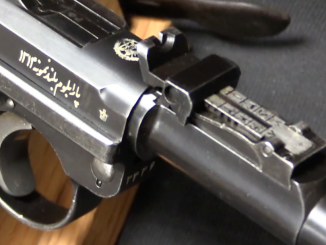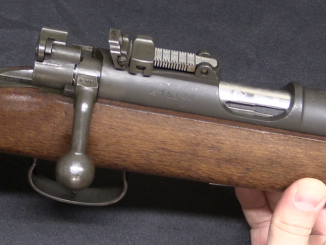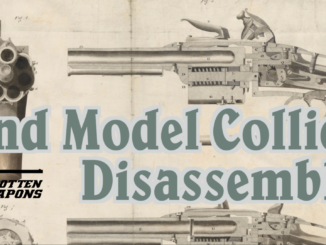This is the second of our two videos from the most recent 2-Gun match, which was designed with an explicit World War One theme. This one is a head to head match between me, kitted out as a BEF rifleman, and Karl, portraying a rear-line German reservist with a Gewehr 88.
The fact that we finished the match within literally one second of each other really says something about the British gear being superior the the Gew88/C96 combination. In any contest with equivalent hardware, Karl’s better shooting skills give him the win. The only reason I was able to win was by having better gear (this especially shows through at the last half of the second stage, where the SMLE allows me to make up a significant deficit from the pistol shooting). That said, every one of the guns we used had some type of problem…
My SMLE had an unusual malfunction on the long range stage, with the bolt head jumping its track. This turned out to be fairly easy to fix by finding the right point in the guide rail where I was able to snap it back into place, but it is something that should not have been able to occur in the first place (and I’m not sure what I did to cause it). This is the second time I have had an odd problem with an Enfield in competition (with different guns), and it really does lead me to believe that the action is simply not as foolproof and robust as the Mauser.
My Webley was a borrowed pistol which has been converted to .45 ACP. I handloaded the ammunition for it (as standard .45ACP is significantly overpressure for a Webley), and actually got the load a bit too light. That caused me a few issues with plates on the second round not falling. On the other hand, I was also using moon clips to reload, which gave me a historical advantage. A British officer would have most likely loaded with individual rounds one at a time (Prideaux speed loaders were around, but not common).
Karl’s Gewehr 88 ran well, but he was hindered a bit by its 547 yard (!) zero, and found that he had to aim at the base of the target stands to make hits on the first stage. Ouch!
His C96 also proved a bit problematic, with he bolt usually not quite going fully into battery. That was the result of a weakening mainspring, which has since been replaced. Even without that problem, though, the C96 is an awkward handgun at best.




The C96 probably shot far more of the opposition in WWI than the great masses of Lugers, 1911s, Steyr-Hahns, and Ruby’s combined.
Why? It was a carbine 1st, and a handgun second.
The 1918 camo colors for the Stahlhelm was suitable at this time: green, yellow ochre, rust brown separated by black borders. Everyone is afraid of the yellow ochre because it creates too much of a contrast for modern tastes, but it was intended to create that contrast.
Helmets with muted colors completely miss the point. At a distance they look like a single color.
Get a version of the SMLE that has a push down bolt release tab at the rear of the track on the action, that allows the bolthead to move up and be removed. Or check the bolthead and action for excessive wear. I’d get a new bolthead with the same number on it and try that first.
I agree. Although I never had a problem with my BSA No I MkIII* there must’ve been a reason why they changed to the push down. Only problem I ever had with my SMLE was the head of the front guard screw snapping off because it was 49 years old and tired. Try to find a part in 1965 when nobody’s got spares yet ! Still shot a 4 inch group.
That’s No.4 and not an SMLE in that case 🙂
But the bolt head jumped the track in front of the charger bridge somehow, rather than jumping the détente. I suspect 100 years of wear might have something to do with it – it is possible that either the track, or the engaging part in the bolt head are worn.
Remember that the average 1918 SMLE will have seen more use than the equivalent Mauser, which will have been obsolete not long after the end of WW1 and put in reserve. The SMLE’s stayed in inventory throughout WW2 and even afterwards. Plus, the British army did, and still does, an awful lot of weapons handling training, so it’s likely that the rifle has really been put through the wringer on being manipulated and dry fired if it stayed in on the military’s books.
Ian, I am curious what specific model and year SMLE you were running. I have an Ishapore in 7.62 that I much enjoy shooting (because of relatively inexpensive ammo) but I am looking for a WWI era SMLE, just curious what vintage yours is. Thanks for the excellent video.
It was a 1918 BSA No1 MkIII*.
I have a Lithgow 1940 SMLE MkIII* and a 1940/41 K98K. Never had a problem out of either one. That looked like a lot of fun. Of course not any fun for those going throur the horrow of the Great War 100 years ago as I type this. Safe shooting everybody. Love the vidio’s Ian.
Someone needs to tell Karl that you lift up the top round on a stripper clip slightly with your index finger and push down with your thumb.
When you just try using your thumb only on the cartridge base the rounds typically bind on the clip and become a pain to force into the magazine.
And I take it that in battle one would actually slam the bolt to eject the clip in order to save a few seconds of one’s time… and for that matter, one’s life could depend on a split-second action!
Karl knows that “technique” and he also knows that you can close the bolt on the inserted stripper clip but he does not prefer those methods as they don’t work across all weapons systems and Karl shoots a lot of different guns.
I have an Enfield 2A where the bolt head will sometimes do the same thing and jump the track. It looks to me like a case of simple wear, as the center of the action rail is noticeably narrower than the ends and the bolt tab is also worn down from cycling. Someday I’ll get around to fixing it. I have seen pictures of a special tool used by armorers to tweak the fit of the rails, so there must have been a reason to make such a tool in the first place. It’s a crying shame that so much of the knowledge base from military armorers working on these great rifles has been lost…
If Lord Kitchener had got his way, our dear Ian could have been carrying a left-handed SMLE. I love this kind of historical equipment testing. Keep it up.
That left hand bias was probably what broke it! 🙂
A question about Lee-Enfields I’ve been wondering about… has anyone ever actually seen/ shot one of the “new” Armalon carbines? British semi-custom jobs based on unissued 60-year old No. 4 actions (probably out of Irish stores – seem to recall a lot of brand-new Irish-surplus No. 4s showing about about 20 years ago) in pistol calibers… 9mm, .38 Super, .40, and .45 using Italian CZ-75 clone magazines, and they apparently did a limited number using Desert Eagle mags in .41, .44 and .50 AE. Really attractive little rifles but the few web sites I’ve seen offering them for sale always list prices in pounds, as in a lot of pounds, so they may be UK only. Lee-Enfields are probably my favorite military bolt and I’ve long had a fondness for pistol-caliber carbines, so this would be just the ticket if I had a spare 1200 pounds or so laying around.
Yes, I have.
They are a bit over-engineered and are quite heavy for their length as a result. They’re quite good though! (They should be for what they cost). They’ve got reduced bolt travel, and are very fast as a result.
Check out Special Interest Arms for pistol caliber conversions.
http://www.specialinterestarms.com/
artech –
Thanks, very cool. The Enfield and Armscorp carbines both look great – probably not enough to distract me from a Ruger 77/357 which I’ve pretty well decided should be my next “just one gun” or bug-out/ zombie apocalypse special, but a lot cooler than mass-produced black-stock stainless. Also really drooled over the Gardner Gun repro – about the only emotion I had over hearing of Colt’s demise was wondering about the $50K custom-shop Gatlings, but the Gardner looks even neater (should I win the lottery, which would require paying voluntary taxes for the mathematically challenged) for approximately half the price.
Hi Jim in Houston. I am Al in Buda Tx. Going to have a living history display at the Kingsbury Air Fair tomorrow NOV 7 rain or shine. We haven’t had any rain this week and we living history folks are going to be popping blanks in several types, GEW 98, Berthier, Lebel, 1892 Ordnance Revolver
1874 Ordnance (officers model) revolver, and also do some pics with my dummy MG’s, 1909 Benet-Mercie, 08/15, Lewis, and Chauchat.
I have a friend who has made some of my dummies and full scale model guns suggest we make up the prototype single barrel Nordenfelt, first a model then maybe the real deal. When you can’t afford ’em, make em. Also have a friend a machinist who is making up replica Mg 08/15’s out of aluminum. He makes race cars so he has to do a little bit here and there, but his work is great. Have been trying to get him to make scarce parts out of steel.
Sorry I missed it, Al! I’m really involved with a good-sized experimental urban farm (oddly, we’re an extension campus of Prairie View A&M, which means that because I do classes and demonstrations on extreme urban agriculture to various groups of visitors means I’m an instructor at a HBCU – Historic Black Colleges and Universities) in 5th Ward called the Last Organic Outpost (fun Facebook page) so my weekend weapon tends to be a weeding fork. Like Ian, it seems like you and I agree that French military weapons, while quirky or at least undeniably French the way a Luger is obviously German, are underrated. Since I’m nominally a handgun leftie for some reason, I’ve always liked the 1892. Like the 1935A I somehow managed to talk myself out of when they were cheap 20 years ago, the price and availability of the ammo for both was a don’t-buy-no-matter-how-cool obstacle. Regards to Buda.
Just a thought- you mention in the video about trying the course with an Arisaka. Have you ever considered trying it with a Carcano? I know from running mine at the range that the packet-loading feature works very, very well. With that stripper clip reloading issue relegated to the back burner, would not the match be much easier to shoot? Hornady made a run of 160 grain .268 bullets specifically for reloading in the 6.5 Carcano and my Model 41 loves them. Many Carcanos shoot spottily with the normal .264 6.5 bullets. You might want to try running a clip-loading Carcano some time, I think you’ll be pleasantly surprised at how easy they are to reload.
As for Italian side-arms, you may need to be careful. Glisenti pistols are too fragile, and Beretta pistols are for officers. Unless I’m totally wrong, you may need to find a Bodeo.
SAY SOMETHING!!!!!!!!
Well, I do have a decent Bodeo. Just need to get some ammo for it…
Well there you go! Give a Carcano a shot, I think you’ll be impressed with the operation!
The handgun use is pretty irrelevant in a combat scenario, Handguns did not win wars, they just feel good weapons for officers that gave them the semblance of authority to command men armed with rifles. On occasion they might have saved a machine gunners, officers, tanker, or downed airman’s life, but in the overall picture they probably killed and wounded more friendlies due to accidents, especially the semi-autos.
And frankly, the Glisenti was as good as any other for that purpose. For that matter, those handmade Chinese junk handguns probably served well in that context.
I’m shocked you don’t have a Webley, Ian.
I’ve been seeking one in shooter condition, cut for 45acp*, any recommendations for where to look?
* (yes, I know special loads & moon clips are required)
My first Webley (actually first handgun) was a .455 uncut original finish 1918 Mark VI. I sold it many years ago and regretted it, if you ever run across 355503 please don’t cut it, I want to buy it back. Biased me completely against the cut versions. Of course I was a Webley nut back then, firing a 1913 .455 Auto with questionable custom ammo. Never got any ammo for my .38 ACP 1910 auto and I regret that.
I’d never cut one. But if one is already cut, I may as well blast with it.
No reason not too but it still breaks my heart to see a butchered Mark VI. I once bought three cut ones for the owner of a country store but of course the cut ones were going for 75 bucks apiece and were considered a great value then…when found the .455’s were going for about half that as at the time .455 ammo was virtually non-existent. The owner used auto-rim which was much more convenient than half moon clips.
I can’t get over the incredible prices that cut mark VI’s are going for now. As a collector piece the .455’s deserve high prices, but the cut Mark VI’s are just…ugh.
Would love to see someone come up with a way to restore cut Mark VI.45’s back to .455. Even a replacement cylinder and extractor would be nice.
Alright bayonet work, with a “war face” of a sort.
What and the Sam Hill are you yardbirds doing, unshouldering those rifles to work the bolts? Drop and give me twenty!
LOL!
I can replicate your malfunction with the SMLE, I have a 1927 No. 1 Mk III/III* that I can lift the bolt head over the rail forward of the charger bridge. My brother has a 1917 Mk III* that cannot. I suspect it is just straight wear on the gun so I have ordered a replacement bolt head to see if it will do the same.
I don’t know how that would happen in use though, when the bolt is in battery the bolt head is held down and cannot be lifted, so an upward force must be applied while the bolt is being cycled, and ejection doesn’t occur until the bolthead is under the bridge, so I doubt the ejection of the case caused it.
Abacab made a very pertinent comment up there, the SMLE saw service in two World Wars, the 8th Army had them from North Africa up into Italy, with various minor modifications as they got overhauled such as deleting the volley fire sight and magazine cut-out. Then they were used for training. We had SMLE’s, No. 4’s, a couple of Brens and a Sterling (no mags, Sten mags but no Stens…) at school. Blank .303 ammo sucks as it’s made from regular brass crimped at the end, so you have a pathetic little tit where a bullet should be to ease the round into the chamber, these were really a pain to load from the magazine.
The bolt head on any Lee-Enfield is supposed to be replaced during overhaul with one that gives the correct headspace, as it’s a rear-locking bolt the receiver will in time give a little. The heads were also case-hardened, the coppery colour they have has to do with copper plating the parts you do not want case-hardened, and then polishing most of the copper off. The part that runs in the rail would not be case-hardened I think, as it would produce undue wear on the receiver which was much harder to replace. The No. 4 had a little catch to prevent the head rotating up once it’s behind the bridge, jamming the action, but having the head rotate up in front of the bridge is new to me. It cannot go to battery like that as there is no space in the chamber face for the extractor except in the correct position. Try to get a proper gunsmith fit a new (or used but good) bolt head and adjust the head space, I’ve no idea how easy it’s going to be to find one the right size these days. They are grand old ladies those SMLE’s.
If you were in the British army you wouldn’t have rifle and pistol both”.
Wrong if you were a junior infantry officer. Later in the war the British heard often enough that the Germans were taught to shoot the English with the white throats, thin knees, or no rifles first that they ordered no ties, slacks, and carry a rifle for front line officers.